The Dell Venue 10 7040 Review
by Brandon Chester on June 30, 2015 8:00 AM ESTGPU Performance
GPU performance is another important aspect of a device. The GPUs in phones and tablets are anywhere between 100 and 200 times faster than they were five years ago, and this has enabled continuous increases in display resolutions and complex applications that were previously not possible. Intel's HD graphics are not typically associated with powerful GPU performance. However, one of the ways Intel's Moorefield chips are different from Bay Trail is that they use PowerVR graphics. In the case of the Venue 8, it uses the PowerVR G6430 with a peak frequency of 533MHz. This is the same GPU found in Apple's A7 SoC, although Apple's implementation is running somewhere around 450MHz.

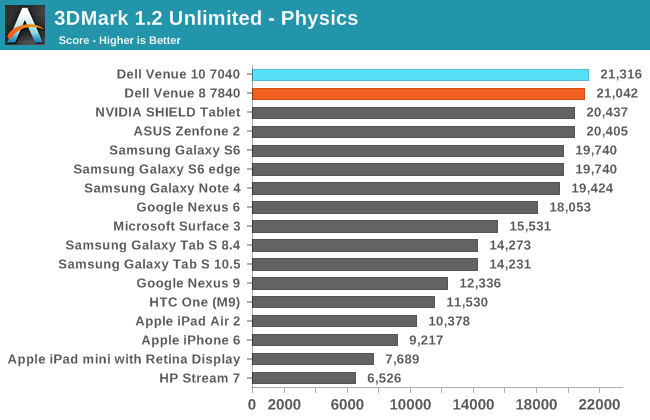
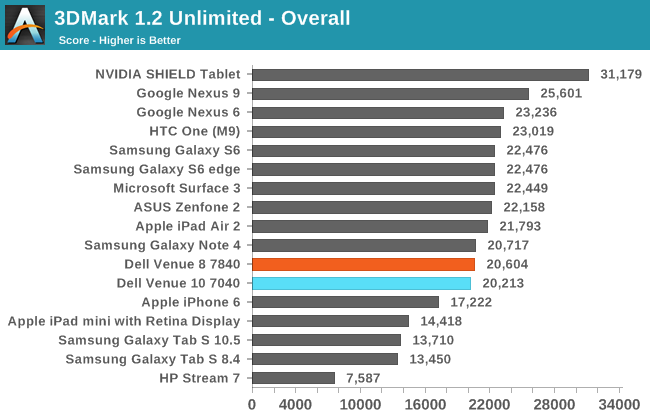
3DMark performance on the Venue 10 is basically identical to the Venue 8. The small difference is most certainly just test variance. As far as the actual performance goes, the performance of the CPU leads to the highest score we've seen in the physics test. In the graphics test it's made clear that G6430 is not competitive with Apple's 8 core "GXA6850" or NVIDIA's single SMX Kepler GPU in Tegra K1. Again, this was easier to overlook when the device in question was a $200 ZenFone, but when you're selling tablets that cost $400-500 or more you can't lag this far behind the competition.
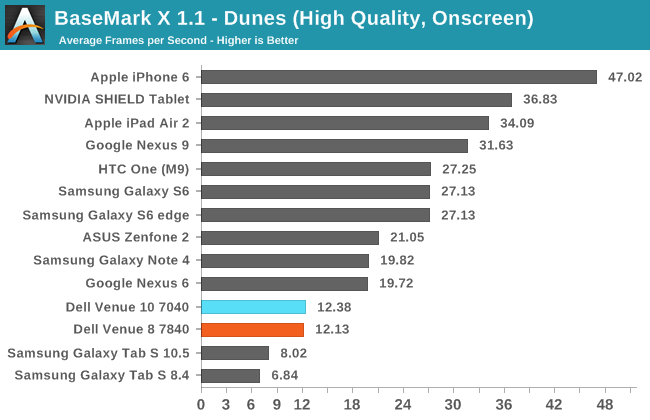
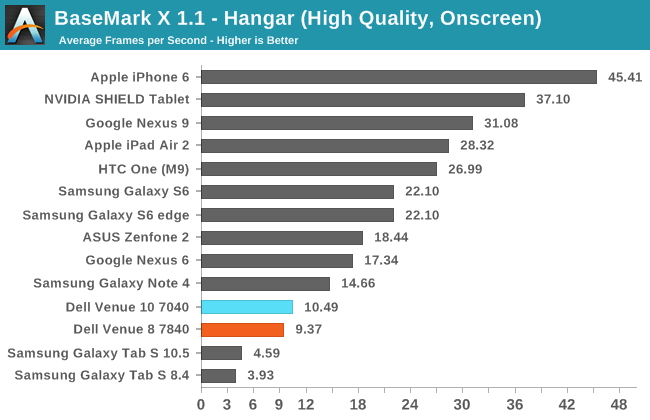
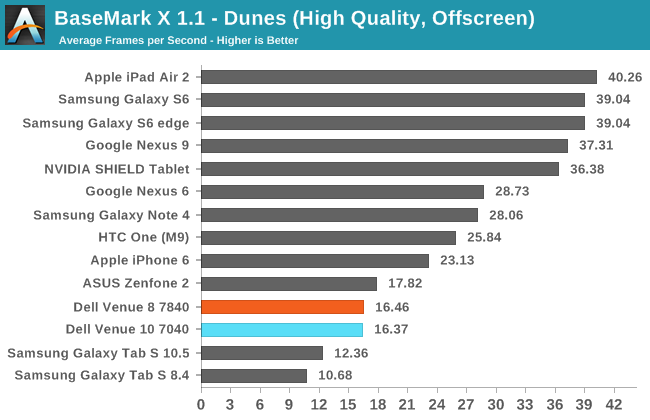
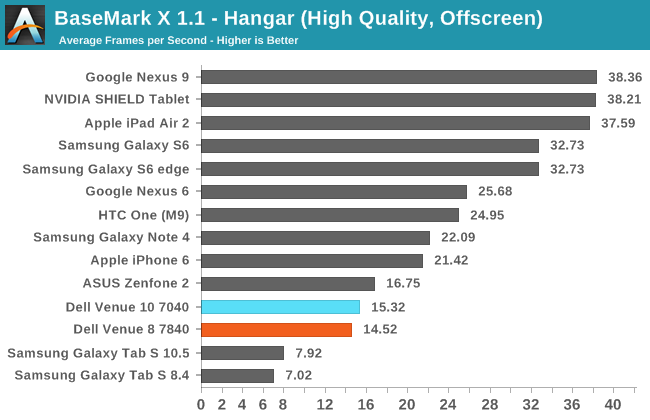
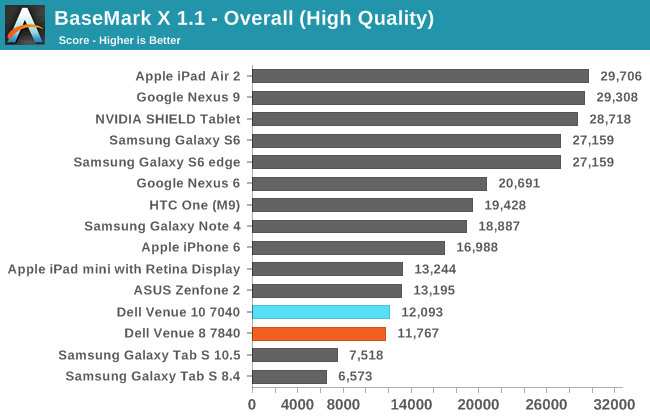
BaseMark X paints a similar picture to 3DMark. In the onscreen tests the performance of the Venue 10 ends up falling behind the ZenFone 2, which is understandable considering that the Venue 10 has twice as many pixels to power. In the 1080p offscreen tests all the G6430 devices have roughly the same performance, and unfortunately they're much slower than competing tablets.

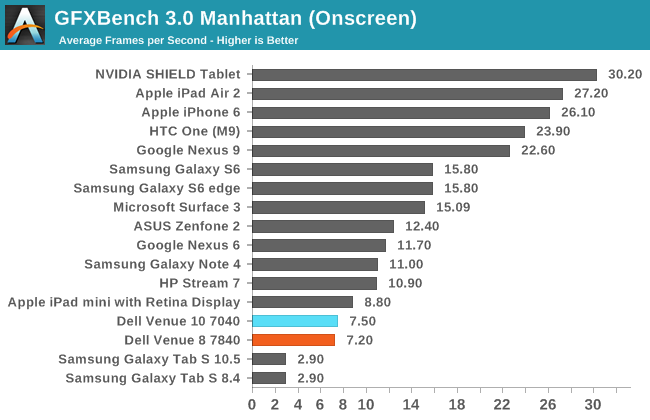

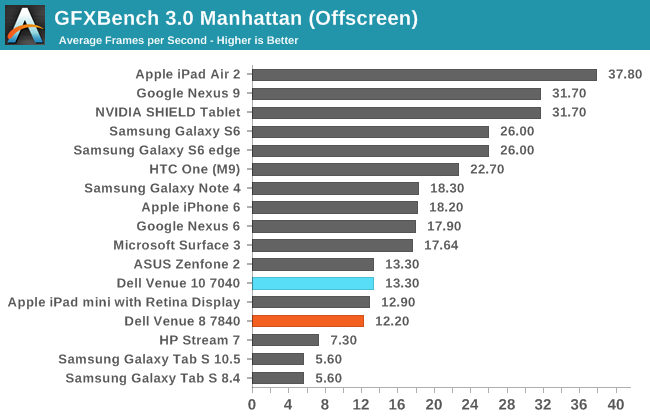
The last GPU test is GFXBench 3.0, and the results reflect the same level of performance as shown in Basemark X and 3DMark. Both Venue 8 tablets perform identically, and both are around the same performance as devices with Apple's A7 SoC.
When evaluating the Venue 10's GPU performance on its own, it performs decently. However, Apple's A8X and both versions of Tegra K1 perform between two and three times faster depending on the test. You can even get Tegra K1 in tablets that cost only $200-300 with the Xiaomi Mi Pad or the NVIDIA Shield Tablet, which makes the Venue 10's performance seem even more underwhelming considering its $499 price tag. G6430 was top notch when it first showed up in Apple's A7 chip, but after almost two generations of improvements since that time it is no longer a competitive GPU in the high end tablet market where devices cost $500 or more.
NAND Performance
Since mobile device manufacturers don't advertise anything about their storage beyond the capacity, it's difficult to find out about a device's storage performance without testing it yourself or reading a review. However, the speed of a device's NAND can significantly impact performance. Slow memory can bottleneck system performance when there are heavy reads or writes occurring, which occurs more often than one would think due to background applications and tasks like automatically downloading and installing app updates.
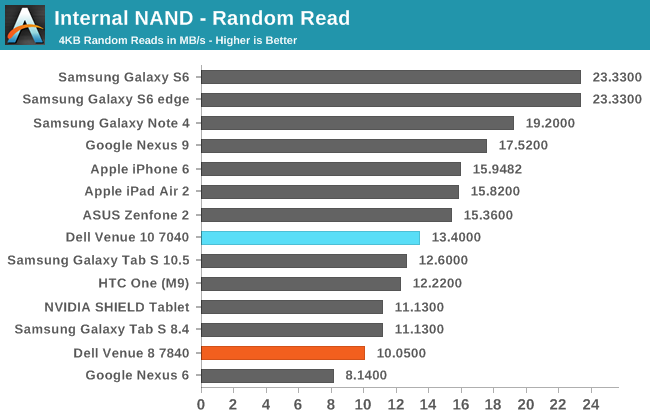
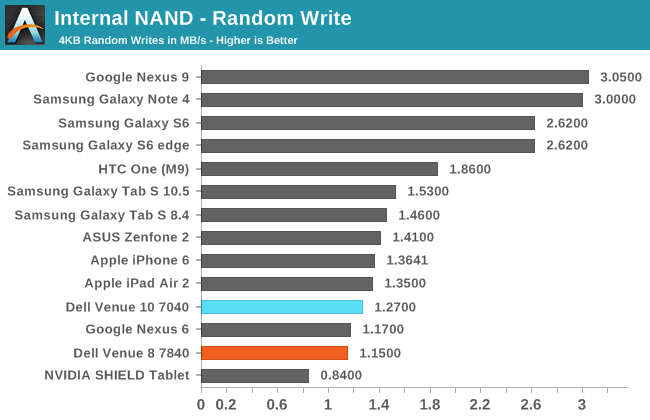
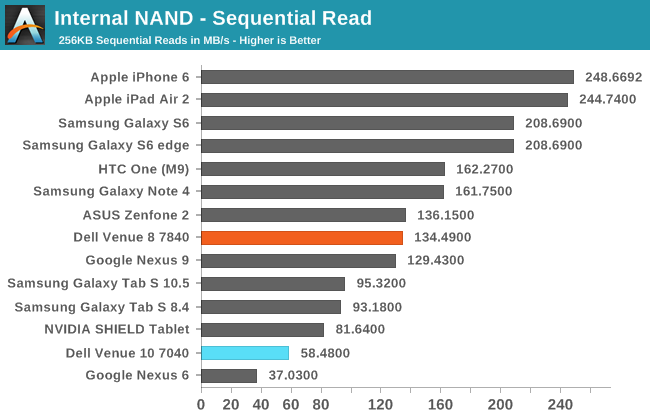

In three of our four tests, the Venue 10 performs roughly as well as the Venue 8, which makes it a fairly average performer. Sequential writes could definitely be improved, but they don't lag far behind other Android tablets like the Nexus 9 or SHIELD Tablet. However, the sequential read speeds are very concerning. 58.48Mbps makes it the second slowest device on the chart, and the only slower device is the Nexus 6 which is crippled by the use of disk encryption.










49 Comments
View All Comments
banner - Tuesday, June 30, 2015 - link
Where is furyx review? What take u so long?milkod2001 - Wednesday, July 1, 2015 - link
It's pointless to bother now with Fury X review. It's been out everywhere already. You will not learn anything new anyway. Fury X is decent but nothing extremely impressive. 980 ti performs slightly better in most games. Both cards suck as single GPU solution for 4k. Wait for 14/16nm next year...Maybe this site guys could do Fury Nano Review as soon as possible to save reputation....
milkod2001 - Wednesday, July 1, 2015 - link
and yeah, this Atom $499 Android tablet is a joke. Anything with Atom should not cost more than $250-300 max. Give me $499 hybrid with W10, core M, 8GB RAM, 128GB SSD,12'' 1080p touch screen ,than we talk.Azune - Wednesday, July 1, 2015 - link
"This is made even more obvious by the fact that the barrel on the end is actually made of metal, and frequently has a lower surface temperature than the rest of the chassis."This is a common misconception. The surface temperature of a metal surface is exactly the same as the temperature of a plastic surface. It feels colder because metal is a very good heat conductor, draining the heat away from your body faster. So the right term would actually be: "feels colder" because the surface temperature is the same.
Veritasium has mode a video about this: https://youtu.be/vqDbMEdLiCs
Brandon Chester - Wednesday, July 1, 2015 - link
My wording was definitely not very good in a scientific sense so I've updated it. I've actually seen that Veritasium video before. Thanks for pointing that out though, it's always good to stay on the side of proper terminology.Azune - Thursday, July 2, 2015 - link
Great, the rest of the review was very good, but that sentence just stood out to me like a sore thumb.zodiacfml - Wednesday, July 1, 2015 - link
Whoa, I thought this is a 2 in 1 Windows 8.1 which looks great if this were a Windows device with a quad core Atom. The implementation is quite poor too, weaker than the Zenfone2.techguymaxc - Wednesday, July 1, 2015 - link
Why in the world would anyone but this for $499? Right now you can get an Asus Transformer Book T300 Chi for the exact same price from the Microsoft Store. http://www.microsoftstore.com/store/msusa/en_US/pd...asfletch - Friday, July 3, 2015 - link
T300 would be totally worth it at that price if it had 16:10 or 3:2 screen and better battery life (around 4-5 hours apparently). Oh well, it's still miles better than this Dell.Ubercake - Wednesday, July 1, 2015 - link
Very thorough review. I feel like I've tried it without even touching it. Nice job!